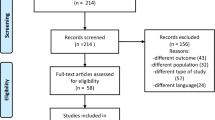Abstract
Objectives
Action potential simulation (APS) is becoming a popular method of pain reduction. Nevertheless, little is known about the efficacy of this relatively new treatment. The aim of this study was to investigate whether APS helps to reduce pain, improves patients’ perception of daily functioning and social participation in patients with fibromyalgia syndrome (FMS).
Materials and methods
Ten patients with FMS according to the American College of Rheumatology (ACR) criteria entered this double blind crossover single-case study. In a period of 20 weeks, the patients underwent two treatment periods of 4 weeks, one with verum and one with placebo, at random, in a double blind fashion. Outcome measures were evaluated on a weekly basis. Primary outcome measure was pain measured with the Fibromyalgia Impact Questionnaire (FIQ) questions 4 and 5, the number of tender points and the total tender point pain intensity score. Both visual inspection and statistical analysis were done to analyse the data from this single-subject design.
Results
Performing visual inspection and statistical analysis, no positive results of the APS treatment were found in this study. Remarkable is the fact that placebo APS had significantly better results than verum APS.
Conclusions
In this single-case study with ten patients (all female), APS was not a helpful method to reduce pain, to improve patients’ perception of daily functioning and social participation in patients with FMS.



Similar content being viewed by others
References
Kaplan KH, Goldenberg DL, Galvin-Nadeau M (1993) The impact of a meditation-based stress reduction program on fibromyalgia. Gen Hosp Psychiatry 15:284–928
Keefe FJ, Caldwell DS (1997) Cognitive behavioral control of arthritis pain. Med Clin North Am 81:277–290
Russell IJ (1998) Advances in fibromyalgia: possible role for central neurochemicals. Am J Med Sci 315:377–384
Wolfe F, Ross K, Anderson J, Russell IJ, Hebert L (1995) The prevalence and characteristics of fibromyalgia in the general population. Arthritis Rheum 38:19–28
Clauw DJ, Chrousos GP (1997) Chronic pain and fatigue syndromes: overlapping clinical and neuroendocrine features and potential pathogenic mechanisms. Neuroimmunomodulation 4:134–153
Weigent DA, Bradley LA, Blalock JE, Alarcon GS (1998) Current concepts in the pathophysiology of abnormal pain perception in fibromyalgia. Am J Med Sci 315:405–412
Goldenberg DL (1997) Fibromyalgia, chronic fatigue syndrome, and myofascial pain syndrome. Curr Opin Rheumatol 9:135–143
Wolfe F, Anderson J, Harkness D, Bennett RM, Caro XJ, Goldenberg DL et al (1997) Health status and disease severity in fibromyalgia: results of a six-center longitudinal study. Arthritis Rheum 40:1571–1579
Sim J, Adams N (1999) Physical and other non-pharmacological interventions for fibromyalgia. Baillieres Best Pract Res Clin Rheumatol 13:507–523
Goldenberg DL, Burckhardt C, Crofford L (2004) Management of fibromyalgia syndrome. JAMA 292:2388–2395
Sluka KA, Walsh D (2003) Transcutaneous electrical nerve stimulation: basic science mechanisms and clinical effectiveness. J Pain 4:109–121
Woolf CJ, Thompson JW (2001) Stimulation-induced analgesia: transcutaneous electrical nerve stimulation (TENS) and vibration. In: Wall EP, Melzack R (eds) Textbook of pain. Churchill Livingstone, Edinburgh, UK
Carroll D, Moore RA, McQuay HJ, Fairman F, Tramer M, Leijon G (2001) Transcutaneous electrical nerve stimulation (TENS) for chronic pain. Cochrane Database Syst Rev CD003222
Odendaal CL, Joubert G (1999) APS therapy—a new way of treating chronic backache—a pilot study. S Afr J Anaesthesiol Analg 5
Wagenaar R (1990) Functional recovery after stroke. VU University Press, Amsterdam
Onghena P, Edgington ES (2005) Customization of pain treatments: single-case design and analysis. Clin J Pain 21:56–68
Wolfe F, Smythe HA, Yunus MB, Bennett RM, Bombardier C, Goldenberg DL et al (1990) The American College of Rheumatology 1990 criteria for the classification of fibromyalgia. Report of the multicenter criteria committee. Arthritis Rheum 33:160–172
Altman DG (1991) Practical statistics for medical research (Hardcover), 2nd edn., Chapman & Hall, London, UK
Okifuji A, Turk DC, Sinclair JD, Starz TW, Marcus DA (1997) A standardized manual tender point survey. I. Development and determination of a threshold point for the identification of positive tender points in fibromyalgia syndrome. J Rheumatol 24:377–383
Hubbard DR, Berkoff GM (1993) Myofascial trigger points show spontaneous needle EMG activity. Spine 18:1803–1807
Jacobs JW, Geenen R, van der HA, Rasker JJ, Bijlsma JW (1995) Are tender point scores assessed by manual palpation in fibromyalgia reliable? An investigation into the variance of tender point scores. Scand J Rheumatol 24:243–247
Dunkl PR, Taylor AG, McConnell GG, Alfano AP, Conaway MR (2000) Responsiveness of fibromyalgia clinical trial outcome measures. J Rheumatol 27:2683–2691
Burckhardt CS, Clark SR, Bennett RM (1991) The fibromyalgia impact questionnaire: development and validation. J Rheumatol 18:728–733
Verhoeven AC, Boers M, van der LS (2000) Validity of the MACTAR questionnaire as a functional index in a rheumatoid arthritis clinical trial. The McMaster Toronto Arthritis. J Rheumatol 27:2801–2809
Cohen ML, Quintner JL (1993) Fibromyalgia syndrome, a problem of tautology. Lancet 342:906–909
Wolfe F (2003) Stop using the American College of Rheumatology criteria in the clinic. J Rheumatol 30:1671–1672
Deluze C, Bosia L, Zirbs A, Chantraine A, Vischer TL (1992) Electroacupuncture in fibromyalgia: results of a controlled trial. BMJ 305:1249–1252
Kaada B (1989) Treatment of fibromyalgia by low-frequency transcutaneous nerve stimulation. Tidsskr Nor Laegeforen 109:2992–2995
Almeida TF, Roizenblatt S, Benedito-Silva AA, Tufik S (2003) The effect of combined therapy (ultrasound and interferential current) on pain and sleep in fibromyalgia. Pain 104:665–672
Cheng N, Van Hoof HH, Bockx E, Hoogmartens MJ, Mulier JC, De Dijcker FJ et al (1982) The effects of electric currents on ATP generation, protein synthesis, and membrane transport of rat skin. Clin Orthop Relat Res 264–272
Acknowledgement
The authors thank R. Luigies from Medeusa B.V. for his cooperation in describing the study protocol, his financial and material support.
Author information
Authors and Affiliations
Corresponding author
Rights and permissions
About this article
Cite this article
Fengler, R.K.B., Jacobs, J.W.G., Bac, M. et al. Action potential simulation (APS) in patients with fibromyalgia syndrome (FMS): a controlled single subject experimental design. Clin Rheumatol 26, 322–329 (2007). https://doi.org/10.1007/s10067-006-0297-z
Received:
Revised:
Accepted:
Published:
Issue Date:
DOI: https://doi.org/10.1007/s10067-006-0297-z




